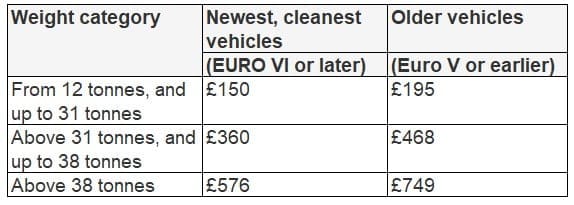Government considers basing new HGV Levy on emissions
The Government has published proposals to replace the suspended HGV Levy with an emissions-based charge, where some operators will see fees rise.
The HGV levy was introduced in 2014, charging HGVs more than 12 tonnes, whether registered in the UK or in other countries, for using or being kept on UK roads.
The levy was originally related to the damage done by the vehicle to the road, but in 2019, it was revised so it also depended on how polluting the vehicle was.
The Government suspended the requirement for hauliers to pay the HGV levy for two years from August 2020 in order to temporarily support the haulage sector and aid Covid-19 pandemic recovery efforts.
The suspension was subsequently extended until August 2023.
The Government has now launched a consultation on two options for when the levy returns in 2023.
The first option is to retain the charging structure and bands which operated before the suspension, meaning that no vehicle would pay more or less than before.
The second option is to reform the levy to make it more reflective of the environmental performance of the vehicle, meaning that most vehicles would pay the same or less, say ministers, but a minority would pay more than before.
Separately, where foreign vehicles are concerned, the Government says it is also minded to reform the charge so that liability is as closely aligned as possible to when a foreign vehicle is used on a road.
The Government says it has been clear that it wanted, in the longer term, to move towards setting a levy based on the environmental performance of the vehicle, as mentioned in the original 2012 consultation on the introduction of the levy.
In 2019, it amended the HGV levy so that as well as reflecting damage to the road, it reflected air quality pollution through varying the levy by Euro emissions class.
However, unlike for cars and other light commercial vehicles (LCVs), where there is a longstanding method for determining the CO2 emissions of a vehicle, there is no such method for HGVs.
Instead, the Government has developed a proposal for reforming the levy so that it is varied according to the weight of the vehicle, since data shows that there is some correlation between weight and CO2 emissions.
This data, it says, is readily available for every vehicle, minimising the system development and compliance costs, and would allow for quick implementation.
POSSIBLE HGV LEVY CHARGES
Given that the relationship between weight and CO2 is a broad one, the Government has proposed just three weight bands, each subdivided into two bands based on vehicle pollutants.
The reformed levy based on environmental performance would take account of: vehicle weight (as an approximate proxy for CO2 emissions); and pollutants, as indicated by the vehicle’s Euro emissions class.
While it said it keeps all rates under review in light of the economic and fiscal outlook, it has published proposed bands and illustrative annual rates for the reformed HGV levy.
The weight category would apply to rigid HGVs, articulated HGVs, and rigid HGVs pulling a trailer.
In cases where a rigid HGV pulls a trailer of four tonnes or more, the weight of the trailer would be added to the weight of the rigid HGV to determine the amount to be paid, it said.

For trailers under four tonnes, only the weight of the rigid vehicle itself would be used to determine the levy.
For historic comparison, for the most common UK vehicle types the amounts paid with this option would be the same or less than when the levy was suspended in 2020, says the Government.
For example, a modern, large articulated HGV would pay £576 for an annual levy, the same as in 2020 (Euro VI emissions class, six axles, registered to carry up to 44 tonnes).
Meanwhile, a modern, medium-sized rigid HGV would pay £150 for an annual levy, compared with £315 in 2020 (Euro VI emissions class, two axles, registered to carry up to 18 tonnes).
For a few vehicle types, it says that there would be some increases compared to their liabilities under the previous levy, due to the new, more environmentally focused structure of the levy.
The largest percentage increases would arise because such vehicles previously paid a very low rate of levy, but these changes would remain modest in absolute terms.
For example, a modern, smaller articulated HGV would pay £360 for an annual levy, compared with £76.50 in 2020 (Euro VI emissions class, six axles, registered to carry 31-34 tonnes).
Furthermore, certain rigid HGVs pulling trailers would face a large percentage increase. However, it says that in some cases, the previous levy rates for such vehicles are lower than the equivalent articulated vehicle, which would no longer be the case.
It says that shorter-term rates would be available for foreign vehicles as before, using the same rules. Specifically, the daily rate would be set at 2% of the annual rate (capped at £9 for Euro VI vehicles and £10 for Euro 0-V vehicles), and the weekly and monthly rates would be 5% and 10% of the annual rate respectively.
Written by Mark Salisbury for Fleet Point © Wednesday, June 22, 2022. Keep up to date with the latest transport news with Fleet Point
Discover more about our fleet and workshop management or contact us for a free demo.
